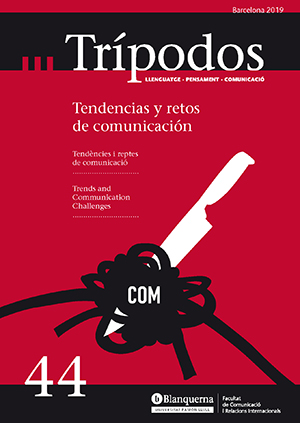Contenido de marca en diarios españoles: concepto, organización y retos de los periodistas implicados
Article Sidebar

Main Article Content
La inversión publicitaria digital se destina de manera mayoritaria a plataformas tecnológicas y redes sociales que son más efectivas en la segmentación y tienen la escala que demandan los anunciantes. Como respuesta, los medios introducen nuevos formatos publicitarios, como el contenido de marca (branded content) y la publicidad nativa para competir aportando un valor diferencial a la publicidad display. El objetivo de este trabajo es analizar cómo se configuran los equipos que elaboran el contenido de marca en seis organizaciones periodísticas españolas (El País, Prensa Ibérica, Vocento, El Confidencial, 20 minutos y El Español). Mediante entrevistas semiestructuradas a seis responsables de esta nueva modalidad publicitaria, se analiza cómo conciben estos nuevos formatos, cómo se organizan y a qué retos éticos y profesionales se enfrentan. Los resultados indican que el contenido de marca ha cobrado protagonismo en la estructura interna de los medios mediante tres modelos (semiautónomo, autónomo, básico) y que los profesionales implicados han abrazado esta estrategia, que ha sido cuestionada en el ámbito académico. Los entrevistados señalan que, si estos formatos se advierten adecuadamente, no se pone en riesgo la credibilidad de la marca periodística. Para ellos el contenido de marca, como la publicidad nativa, será un pilar fundamental en el modelo de negocio de sus organizaciones.
Branded Content in Spanish Newspapers: Concept, Organization and Challenges for the Journalists Involved
Spending on digital advertising is currently being allocated primarily to social networks and technological platforms that are more effective at segmentation and offer the scalability that advertisers want. Media outlets have responded by introducing new advertising formats that are more qualitative, such as branded content and native advertising, that differentiate them from the aforementioned technological platforms and add more value than display advertising. The aim of this paper is to analyze how the teams that create branded content are structured at six journalistic organizations in Spain (El País, Prensa Ibérica, Vocento, El Confidencial, 20 minutos and El Español). Semi-structured interviews with the individuals responsible for this new advertising alternative were used to analyze how they view this new format, how they are structured, and what ethical and professional challenges they face. The results indicate that branded content has gained importance in the internal structure of media outlets in the form of three models (semi-autonomous, autonomous and basic), and that the professionals involved have embraced this strategy, which has been questioned in the academic arena. Interviewees pointed out that by inserting an appropriate disclaimer in these formats, the credibility of the journalistic brand is not endangered. They believe that branded content and native advertising will become fundamental pillars for their business models.